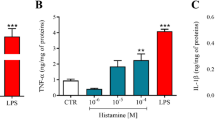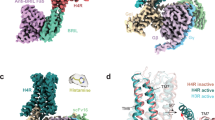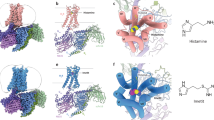Abstract
AGENTS which increase the intracellular level of adenosine 3′-5′-monophosphate (cyclic AMP) in human leukocyte preparations such as the catecholamines, methylxanthines and prostaglandins, inhibit the antigen induced, IgE antibody mediated release of histamine from human leukocytes (basophils)1–3. Not only are the dose response relationships for increased cyclic AMP levels and the inhibition of histamine release similar, but the kinetics of the two events are also parallel and it is accepted as a working hypothesis that changes in the cyclic AMP level of human basophils (and mast cells) modulate the in vitro allergic response4–6. Recently, we showed that exogenous histamine could increase the cyclic AMP level of human leukocyte preparations and stop the release of endogenous histamine. This occurred at concentrations of histamine (about 10−6 M) which are present in the cell suspension under study7. For this reason we suggested that histamine could “feedback” to control the spread of an allergic response by decreasing the response of other target cells (tissue mast cells, blood basophils) to an allergenic challenge. No clear effect of antihistamines on the inhibition of histamine release by histamine was observed: concentrations up to 10−3 M to 10−4 M of several antihistamines had little effect and higher concentrations of these drugs either caused inhibition of histamine release themselves or were cytotoxic2,7.
This is a preview of subscription content, access via your institution
Access options
Subscribe to this journal
Receive 51 print issues and online access
$199.00 per year
only $3.90 per issue
Buy this article
- Purchase on SpringerLink
- Instant access to full article PDF
Prices may be subject to local taxes which are calculated during checkout
Similar content being viewed by others
References
Lichtenstein, L. M., and Margolis, S., Science, 161, 902 (1968).
Bourne, H. R., Lichtenstein, L. M., and Melmon, K. L., J. Immun., 108, 695 (1972).
Ishizaka, T., DeBernardo, R., Tomioka, H., Lichtenstein, L. M., and Ishizaka, K., J. Immun., 108, 1000 (1972).
Lichtenstein, L. M., Henney, C. S., Bourne, H. R., and Greenough, W. B., J. Clin. Invest., (in the press).
Bourne, H. R., Lehrer, R. I., Lichtenstein, L. M., Weissmann, G., and Zurier, R., J. clin. Invest. (in the press).
Orange, R. P., Austen, W. G., and Austen, K. F., J. Exp. Med., 134, 1365 (1971).
Bourne, H. R., Melmon, K. L., and Lichtenstein, L. M., Science, 173, 743 (1971).
Ash, A. S. F., and Schild, H. O., Brit. J. Pharm., 27, 427 (1966).
Black, J. W., Duncan, W. A. M., Durant, C. J., Ganellin, C. R., and Parsons, E. M., Nature, 236, 385 (1972).
Lichtenstein, L. M., and Osler, A. G., J. Exp. Med., 120, 507 (1964).
Lichtenstein, L. M., J. Immun., 107, 1122 (1971).
Brown, B. L., Albano, J. D. M., Ekins, R. P., and Shgerzi, A. M., Biochem. J., 121, 561 (1971).
Gillespie, E., and Lichtenstein, L. M., J. Clin. Invest., 51, 2941 (1972).
Author information
Authors and Affiliations
Rights and permissions
About this article
Cite this article
LICHTENSTEIN, L., GILLESPIE, E. Inhibition of Histamine Release by Histamine controlled by H2 Receptor. Nature 244, 287–288 (1973). https://doi.org/10.1038/244287a0
Received:
Revised:
Issue date:
DOI: https://doi.org/10.1038/244287a0
This article is cited by
-
Histamine receptors and COVID-19
Inflammation Research (2021)
-
Potential immunological consequences of pharmacological suppression of gastric acid production in patients with multiple sclerosis
BMC Medicine (2012)
-
Classification and biological distribution of histamine receptor sub-types
Agents and Actions (1994)
-
Modulation of IgE-mediated histamine release from human leukocytes by a new class of histamine H2-agonists
Agents and Actions (1992)



